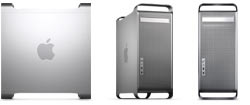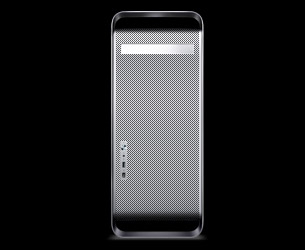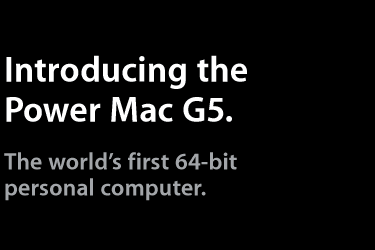The
Power Mac G5 is the world’s fastest personal computer and the first
with a 64-bit processor — which means it breaks the 4 gigabyte barrier
and can use up to 8 gigabytes of main memory. The new G5 processor —
available at speeds up to dual 2GHz with a new ultrahigh-bandwidth
system architecture featuring AGP 8X and PCI-X — makes the Power Mac G5
a breakthrough in desktop processing power. And models start at just
$1999.
How fast is the world’s fastest personal computer?
The new Power Mac G5 throttles past both the fastest Pentium 4 and a dual-processor Xeon workstation when tested using industry standard SPEC CPU 2000 benchmarks. The SPEC CPU2000 benchmark suite comprises four metrics —
SPECint_base2000, SPECfp_base2000, SPECint_rate_base2000, and
SPECfp_rate_base2000 — to represent different performance
characteristics of the system.
SPECint_base2000 and SPECfp_base2000 measure the speed of a single task
— either an integer calculation or a floating-point calculation —
executing on a single processor. Each test measures how long the
processor takes to complete the benchmark set of single tasks.

The “SPEC rate” metrics - SPECint_rate_base2000 and
SPECfp_rate_base2000, recognize multiple processors and more accurately
demonstrate the performance of a dual processor system — which are, of
course, the fastest systems. The results should make your pulse race
just a little bit faster.

”World’s fastest” based on SPECrate® 2000 benchmark results and leading professional application performance tests against 3 GHz Pentium 4-based Dell Dimension 8300 and 3.06 GHz Dual Xeon-based Dell Precision 650. SPECrate® 2000 benchmarks run with GCC 3.3 and independently tested, full report available from Veritest; professional applications tested by Apple, June 2003.
Ready for the real world
The PowerPC G5 processor dramatically accelerates performance in real world applications, too. When compared head-to-head against the same PCs, in a large series of Photoshop tests the dual 2GHz Power Mac G5 is 2.2 times faster than the 3GHz Pentium 4-based system and almost twice as fast as the dual 3.06GHz Xeon-based system. Additional performance tests reveal similar performance gains for professional music and audio creation, and scientific analysis of genetic research.
Bandwidth to burn
The Power Mac G5’s ultra-high bandwidth system architecture features a
1GHz frontside bus — one on each processor — for maximum throughput.
And a point-to-point system controller lets data move directly between
subsystems, without affecting processor function.
PCI-X expansion
 The Power Mac G5 comes with
three PCI-X slots, giving you the benefit of the newest advance in PCI
technology. The PCI-X protocol is perfect for high-performance PCI
devices, increasing speeds from 33MHz to 133MHz and throughput from
266MBps to 2GBps. The Power Mac G5 comes with
three PCI-X slots, giving you the benefit of the newest advance in PCI
technology. The PCI-X protocol is perfect for high-performance PCI
devices, increasing speeds from 33MHz to 133MHz and throughput from
266MBps to 2GBps.
 High-speed AGP 8X Pro graphics bus High-speed AGP 8X Pro graphics bus
Compared with the AGP 4X interface, the Power Mac G5’s AGP 8X Pro
graphics bus effectively doubles the maximum transfer rate and doubles
the amount of data transferred in a single AGP bus cycle. The 66MHz AGP
8X Pro bus strobes eight times per clock cycle, achieving a 533MHz data
rate and a maximum bandwidth of 2.1GB per second — ideal for the
ultrafast graphics cards it ships with, like the ATI Radeon 9800 Pro or
NVIDIA GeForce FX 5200 Ultra.
 FireWire 800,
USB 2.0 and high-performance I/O FireWire 800,
USB 2.0 and high-performance I/O
The Power Mac G5 ships with a FireWire 800 port and three USB 2.0 ports
(plus two USB 1.1 ports on the keyboard). Gigabit Ethernet, FireWire,
USB 2.0 and optical digital and analog audio are all integrated through
two bidirectional 16-bit, 800MHz HyperTransport interconnects for a
maximum throughput of 3.2GB per second.
 Three powerful models Three powerful models
The Power Mac G5 product line comes in three muscular configurations —
1.6GHz, 1.8GHz and a dual 2GHz model. They all feature the legendary
SuperDrive (DVD-R/CD-RW) as standard equipment across the line. And of
course they come with two FireWire 400 ports, three PCI expansion
slots, ADC connector, DVI connector, analog audio in, analog audio out,
optical S/PDIF in, optical S/PDIF out, front headphone and speaker jack
and built-in Gigabit Ethernet — all as standard equipment. All models
are AirPort Extreme-ready, and offer Bluetooth capability as a
build-to-order option.
|
|



